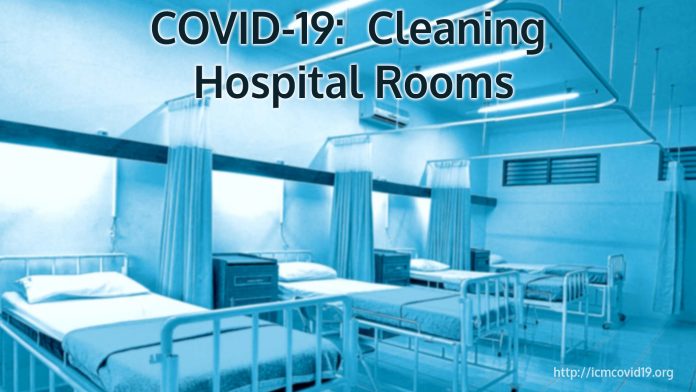Introduction
How to clean rooms during a patient stay, and after they have been transferred or discharged
1. While the patient is in the room
Cleaning and decontamination should only be performed by staff trained in the use of the appropriate PPE. In some instances this may need to be trained clinical staff rather than domestic staff, in which case clinical staff may require additional training on standards and order of cleaning.
After cleaning with neutral detergent, a chlorine-based disinfectant should be used, in the form of a solution at a minimum strength of 1,000ppm available chlorine. If an alternative disinfectant is used within the organisation, the local infection prevention and control team (IPCT) should be consulted on this to ensure that this is effective against enveloped viruses. Manufacturers’ guidance and recommended product ‘contact time’ must be followed for all cleaning/disinfectant solutions/products.
The main patient isolation room should be cleaned at least twice daily. Body fluid spills should be decontaminated promptly.
To ensure the appropriate use of PPE and that an adequate level of cleaning is undertaken which is consistent with the recommendations in this document, it is strongly recommended that cleaning of isolation areas is undertaken separately to the cleaning of other clinical areas.
Dedicated or disposable equipment (such as mop heads, cloths) must be used for environmental decontamination. Reusable equipment (such as mop handles, buckets) must be decontaminated after use with a chlorine-based disinfectant as described above. Communal cleaning trollies should not enter the room.
2. Cleaning the room once the patient has been discharged or left the room
Before entering the room, perform hand hygiene then put on a disposable plastic apron and gloves. If a risk assessment indicates that a higher level of contamination may be present or there is visible contamination with body fluids, then the need for additional PPE should be considered.
- Collect all cleaning equipment and healthcare waste bags before entering the room
- The person responsible for undertaking the cleaning with detergent and disinfectant should be trained in the process
- Remove all healthcare waste and any other disposable items
- Treat bedding and bed screens as infectious linen; do not shake linen and avoid all necessary agitation
- Clean patient care equipment according to manufacturer’s instructions, and where possible with chlorine-based disinfectant, 70% alcohol or an alternative disinfectant used within the organisation that is effective against enveloped viruses; where equipment is not readily amenable to cleaning, such as blood pressure cuffs, it should be disposed of to waste
- Clean all surfaces, beds and bathrooms with a neutral detergent, followed by a chlorine-based disinfectant, in the form of a solution at a minimum strength of 1,000ppm available chlorine
- If an alternative disinfectant is used within the organisation, the local IPCT should be consulted on this to ensure that this is effective against enveloped viruses
- Particular attention is needed to cleaning of toilets/bathrooms as COVID-19 has been frequently found to contaminate surfaces in these areas
- Use dedicated or disposable equipment (such as mop heads, cloths) for environmental decontamination and dispose of them as infectious clinical waste
- Reusable equipment (such as mop handles, buckets) must be decontaminated after use
- Communal cleaning trollies should not enter the room
Sources & links
- gov.uk | Reducing the risk of transmission of COVID-19 in the hospital setting| Link

